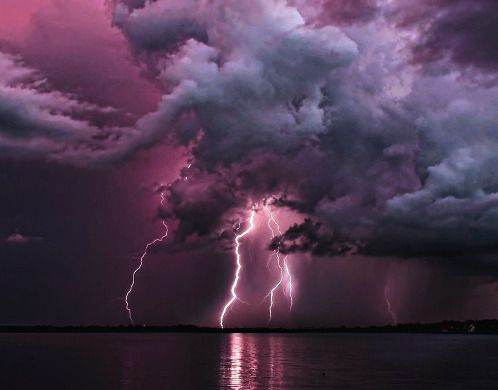Love This One! #lightning
Love this one! #lightning

More Posts from Elvaltal and Others
Beautiful!!!

The Pleiades in Infrared
Looking forward to seeing the data from these satellites! The more data, the better!





CYGNSS rockets into orbit atop Pegasus
The first Cygnus launch from Cape Canaveral in nearly 10 years successfully placed NASA’s eight CYGNSS satellite into orbits Thursday, December 15. Pegasus, attached to the belly of Orbital ATK’s L-1011 Stargazer aircraft, lifted off from Cape Canaveral Air Force Station’s Skid Strip runway at 7:38am EDT. After reaching an altitude of 39,000 feet and within the 10 by 40 mile launch box, Pegasus was commanded for release, falling away from the mothership at 8:37am. Less than five seconds later, the first stage ignited, beginning a 14-minute climb to orbit for Pegasus and the eight CYGNSS satellites.
CYGNSS, short for Cyclone Global Navigation Satellite System, will use high-fidelity GPS signals to help forecasters better measure and predict hurricanes. In honor of the storm recently affecting the space coast, the Pegasus rocket launching CYGNSS was named Matthew. This was the 43rd launch of the Pegasus rocket, which made history in 1990 as the world’s first successfully-launched commercially-developed rocket vehicle. It remains the only air-launched rocket system in operation. CYGNSS was originally scheduled for launch Monday, but a faulty hydraulic pump in the rocket’s release mechanism promoted a delay into today. P/C: NASA.

These new type of satellites are revolutionizing how scientists will keep an eye on the Earth for years to come! Check out the CYGNSS one! :)
6 Tiny Satellites That Are Changing How We See Earth

HARP: Hyper-Angular Rainbow Polarimeter
What’s better than taking a picture of a cloud to figure out its size and shape? Taking a bunch of pictures all around it. That way you get a three-dimensional view without having to worry about missing something. The HARP CubeSat is going to do just that: make observations of cloud droplets and tiny airborne particles like soot and dust with a modified camera lens from multiple angles. This will give us a full rendering of what’s going on inside the clouds, specifically, how those airborne particles act as “seeds” for water vapor to condense on and form cloud droplets. Since so many of those particles are in the air as a result of man-made pollution, we want to understand how they may be affecting clouds, weather and climate.

RAVAN: Radiometer Assessment using Vertically Aligned Nanotubes
Anyone who’s worn a black shirt on a summer day knows how much sunlight and heat it absorbs. The RAVAN 3-unit CubeSat, however, carries “blacker than black” technology – carbon nanotubes set up like a bundle of drinking straws that suck up nearly all the sunlight and energy that reach them to the point that your black shirt seems merely dark grey in comparison. Flying in low Earth orbit, RAVAN’s super sensitive instrument will detect tiny changes in the amount of sunlight and energy passing into and out of the top of the atmosphere. The amount of energy passing through the top of the atmosphere is where the net accounting of Earth’s energy budget happens – one of the major measurements we need in order to understand the effects of greenhouse gases on global warming and climate change.

MiRaTA: Microwave Radiometer Technology Acceleration
That long skinny piece coming out of the bottom right side under the solar panel? That’s a measuring tape. It’s doubling as a communications antenna on the MiRaTA CubeSat that will be a mini-weather station in space. This 3-unit, shoe box-sized satellite is testing out new, miniaturized technology to measure temperature, water vapor, and cloud ice in the atmosphere. They’ll be tracking major storms, including hurricanes, as well as everyday weather. If this test flight is successful, the new, smaller technology will likely be incorporated into major – large – weather satellite missions in the future that are part of our national infrastructure.

IceCube
The aptly named IceCube will measure – you guessed it – ice in our atmosphere. Unlike the droplets that make up rain, ice is one of the harder things to measure from space. IceCube is a 3-unit CubeSat about the size of a loaf of bread outfitted with a new high-frequency microwave radiometer, an instrument that measures naturally occurring radiation emitted by stuff in the atmosphere – cloud droplets, rain, and the ice particles at the tops of clouds. This will be the first space test of the new microwave radiometer that has to balance its tiny size and low power with being sensitive enough to detect cloud ice.

CYGNSS: Cyclone, Global Navigation Satellite System
What do GPS signals do when they’re not talking to your phone? A lot of them are just bouncing harmlessly off the planet’s surface – a fact that the CYGNSS mission is taking advantage of to measure wind speed over the ocean. Eight identical small satellites, each about the size of a microwave oven, flying in formation carry custom modified GPS receivers pointed at the oceans. When the water is smooth – not windy – the GPS signals reflect back uniformly, like the moon on a pond reflected as if in a mirror. When the water is choppy – windy – the signals reflect back in in the same direction but distorted, like the moon reflection on a choppy pond being distorted by ripples. Flying eight satellites in formation means the CYGNSS mission can measure wind speed across more of the ocean at once, which will help with understanding tropical storms and hurricanes.

TROPICS: Time-Resolved Observations of Precipitation structure and storm Intensity with a Constellation of Smallsats
An important way to improve forecasts of hurricane and tropical cyclone intensity is to see what’s going on inside and around them while they’re happening. That’s the goal of the TROPICS mission, 12 CubeSats that will fly in formation to track the temperature and humidity of storm environments. The TROPICS CubeSats will get very frequent measurements, similar to X-rays, that cut through the overall cloud-cover so we can see the storm’s underlying structure. The storm structures known as the eyewall – tall clouds, wind and rain around the eye – and rainbands – the rainy parts of the spiral arms – give us clues about whether a storm is primed to intensify into a category 4 or 5 storm, something everyone in their path needs to know.
Learn more the world of small satellites at: https://www.nasa.gov/mission_pages/smallsats
Make sure to follow us on Tumblr for your regular dose of space: http://nasa.tumblr.com
Wow! #lightning

WOW! Simply amazing #aurora!!

Northern light reflection, Tromsø, Norway by Kiredjian Joris
Great shot! #lightning

Incredible lightning shot in Austin, Texas! credit: Christopher V. Sherman
Wow!! Amazing #lightning shot!

Broome, Western Australia | paulmichael
More #aurora shots! Gorgeous!!!😊

Kirkjufell, Iceland
Wow is right!! Great composite! #lightning

Сomposite shot of a thunderstorm in Gurgaon (India) on April 5, 2017. Here are 89 photos! WOW! credit: Jan Wellmann
Beautiful! #milkyway

Shooting star over Mt. Rainer, Washington | by Tanner Stewart
-
 babe-can-i-call reblogged this · 5 days ago
babe-can-i-call reblogged this · 5 days ago -
 paigeedanielle reblogged this · 5 days ago
paigeedanielle reblogged this · 5 days ago -
 nocturniss reblogged this · 5 days ago
nocturniss reblogged this · 5 days ago -
 jaunoir reblogged this · 5 days ago
jaunoir reblogged this · 5 days ago -
 markusjahlive liked this · 6 days ago
markusjahlive liked this · 6 days ago -
 genesisonelei reblogged this · 1 week ago
genesisonelei reblogged this · 1 week ago -
 genesisonelei liked this · 1 week ago
genesisonelei liked this · 1 week ago -
 costumarias reblogged this · 1 week ago
costumarias reblogged this · 1 week ago -
 pretoooh00xz reblogged this · 1 week ago
pretoooh00xz reblogged this · 1 week ago -
 definitedangermaker reblogged this · 1 week ago
definitedangermaker reblogged this · 1 week ago -
 definitedangermaker reblogged this · 1 week ago
definitedangermaker reblogged this · 1 week ago -
 definitedangermaker liked this · 1 week ago
definitedangermaker liked this · 1 week ago -
 platinumalldayeveryday liked this · 1 week ago
platinumalldayeveryday liked this · 1 week ago -
 alakosarmin liked this · 1 week ago
alakosarmin liked this · 1 week ago -
 missgoingdown reblogged this · 1 week ago
missgoingdown reblogged this · 1 week ago -
 dreanlamd reblogged this · 1 week ago
dreanlamd reblogged this · 1 week ago -
 sussurriegrida99 liked this · 1 week ago
sussurriegrida99 liked this · 1 week ago -
 salm-007 liked this · 2 weeks ago
salm-007 liked this · 2 weeks ago -
 hewasseducedagain reblogged this · 2 weeks ago
hewasseducedagain reblogged this · 2 weeks ago -
 sonoraswinds liked this · 2 weeks ago
sonoraswinds liked this · 2 weeks ago -
 yikesitslush reblogged this · 2 weeks ago
yikesitslush reblogged this · 2 weeks ago -
 slurmsmackenzie94 liked this · 2 weeks ago
slurmsmackenzie94 liked this · 2 weeks ago -
 garuda606 liked this · 2 weeks ago
garuda606 liked this · 2 weeks ago -
 thorn861 reblogged this · 2 weeks ago
thorn861 reblogged this · 2 weeks ago -
 kingfggtxx3 reblogged this · 2 weeks ago
kingfggtxx3 reblogged this · 2 weeks ago -
 cuppyycakkee reblogged this · 2 weeks ago
cuppyycakkee reblogged this · 2 weeks ago -
 drahgonfly reblogged this · 2 weeks ago
drahgonfly reblogged this · 2 weeks ago -
 livelong-and-pr0sper reblogged this · 2 weeks ago
livelong-and-pr0sper reblogged this · 2 weeks ago -
 fur4brains reblogged this · 2 weeks ago
fur4brains reblogged this · 2 weeks ago -
 whisper-overseer reblogged this · 2 weeks ago
whisper-overseer reblogged this · 2 weeks ago -
 oneinkc liked this · 2 weeks ago
oneinkc liked this · 2 weeks ago -
 sensualflutterby liked this · 2 weeks ago
sensualflutterby liked this · 2 weeks ago -
 strangemortalworld reblogged this · 2 weeks ago
strangemortalworld reblogged this · 2 weeks ago -
 mist-tickle reblogged this · 2 weeks ago
mist-tickle reblogged this · 2 weeks ago -
 antinerciazero reblogged this · 2 weeks ago
antinerciazero reblogged this · 2 weeks ago -
 leoqueenie reblogged this · 2 weeks ago
leoqueenie reblogged this · 2 weeks ago -
 test123xz liked this · 2 weeks ago
test123xz liked this · 2 weeks ago -
 redk69 liked this · 2 weeks ago
redk69 liked this · 2 weeks ago -
 clube-do-prazer reblogged this · 2 weeks ago
clube-do-prazer reblogged this · 2 weeks ago -
 strangetigerperfection reblogged this · 2 weeks ago
strangetigerperfection reblogged this · 2 weeks ago -
 strangetigerperfection liked this · 2 weeks ago
strangetigerperfection liked this · 2 weeks ago -
 snowjohn77 liked this · 2 weeks ago
snowjohn77 liked this · 2 weeks ago -
 jskfldf reblogged this · 2 weeks ago
jskfldf reblogged this · 2 weeks ago -
 rusilver reblogged this · 2 weeks ago
rusilver reblogged this · 2 weeks ago -
 lezbeh0nest092 reblogged this · 2 weeks ago
lezbeh0nest092 reblogged this · 2 weeks ago